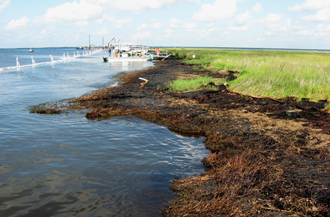Engineering to Navigate Next Disaster
Engineers from Tulane and Louisiana State universities teamed up to draft an article that explores key issues related to last year's Gulf of Mexico Macondo well oil spill and proposes the need for predictive modeling tools to forecast and manage the next spill.

Effects of the Deepwater Horizon oil spill are obvious along the shorelines of Bay Jimmy and Barataria Bay. Engineers are proposing the use of predictive modeling tools to forecast and manage the next spill. (Photo courtesy of the State of Louisiana)
The paper in the Feb. 1 edition of Environmental Engineering Science focuses on what chemical engineers and environmental engineers can do to identify and solve these problems.
One major research concern is the huge clouds and plumes of hydrocarbons that formed in the Gulf waters up to 2,500 feet below the surface after the April 3, 2010, Deepwater Horizon drilling rig explosion.
The authors say the plumes appear to have been caused by the use of dispersants applied directly at the wellhead, some 5,000 feet below the surface. The application of dispersants at those depths is unique to this spill and something that needs to be understood, the researchers say. Previously dispersants were sprayed only on surface slicks.
In the article, they also raise questions about what happened to the 4.6 to 5.4 million barrels of oil and gas estimated to have entered the water column. The oil has to be accounted for to understand any potential impact on the ecosystem, says Vijay John, the Leo S. Weil Professor of Engineering at Tulane.
The authors suggest that predictive modeling tools developed and used by engineers, scientists and mathematicians are necessary for future spills to direct oil remediation resources, for risk assessment and to project ecological damage.
Four Tulane professors of chemical and biomolecular engineering John, Kyriakos Papadopoulos, Lawrence Pratt and Noshir Pesika contributed to the article in collaboration with LSU professors Louis Thibodeaux and Kalliat Valsaraj.
Belinda Lacoste is a student studying journalism in the School of Continuing Studies and a staff member who writes for the School of Science and Engineering.
